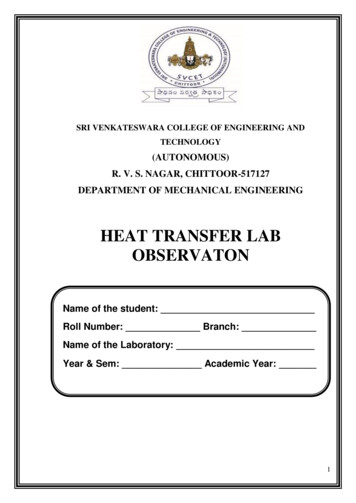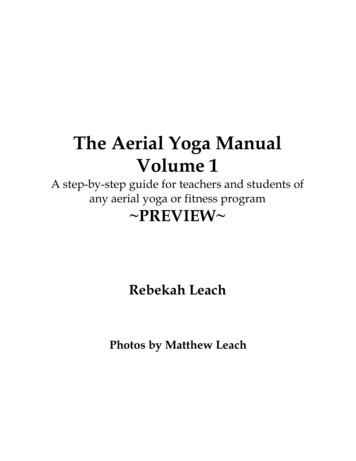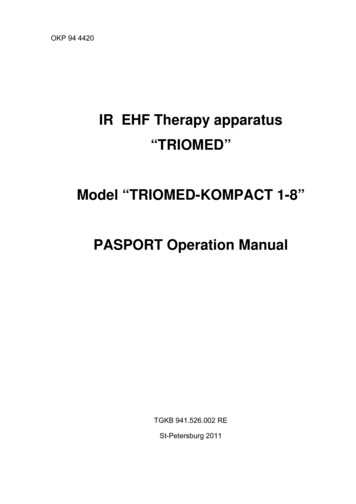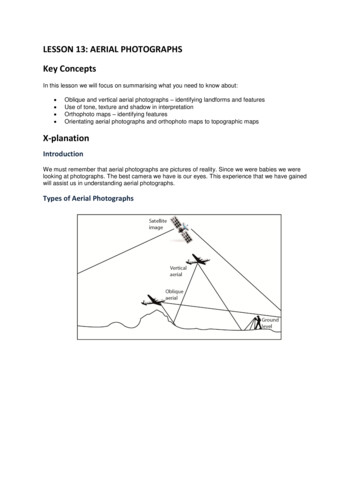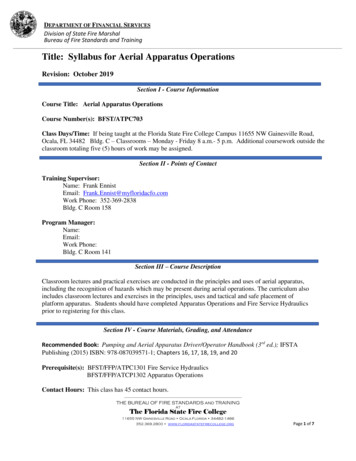
Transcription
DEPARTMENT OF FINANCIAL SERVICESDivision of State Fire MarshalBureau of Fire Standards and TrainingTitle: Syllabus for Aerial Apparatus OperationsRevision: October 2019Section I - Course InformationCourse Title: Aerial Apparatus OperationsCourse Number(s): BFST/ATPC703Class Days/Time: If being taught at the Florida State Fire College Campus 11655 NW Gainesville Road,Ocala, FL 34482 Bldg. C – Classrooms – Monday - Friday 8 a.m.- 5 p.m. Additional coursework outside theclassroom totaling five (5) hours of work may be assigned.Section II - Points of ContactTraining Supervisor:Name: Frank EnnistEmail: Frank.Ennist@myfloridacfo.comWork Phone: 352-369-2838Bldg. C Room 158Program Manager:Name:Email:Work Phone:Bldg. C Room 141Section III – Course DescriptionClassroom lectures and practical exercises are conducted in the principles and uses of aerial apparatus,including the recognition of hazards which may be present during aerial operations. The curriculum alsoincludes classroom lectures and exercises in the principles, uses and tactical and safe placement ofplatform apparatus. Students should have completed Apparatus Operations and Fire Service Hydraulicsprior to registering for this class.Section IV - Course Materials, Grading, and AttendanceRecommended Book: Pumping and Aerial Apparatus Driver/Operator Handbook (3rd ed.); IFSTAPublishing (2015) ISBN: 978-087039571-1; Chapters 16, 17, 18, 19, and 20Prerequisite(s): BFST/FFP/ATPC1301 Fire Service HydraulicsBFST/FFP/ATCP1302 Apparatus OperationsContact Hours: This class has 45 contact hours.THE BUREAU OF FIRE STANDARDS and TRAININGATThe Florida State Fire College11655 NW Gainesville Road Ocala Florida 34482-1486352.369.2800 www.floridastatefirecollege.orgPage 1 of 7
Continuing Educations Units (CEU’s): NonePre-Course Assignment: NoneRequired Materials: Paper, pens, USB portable storage device (thumb drive). Apparatus andappliances for driving/pumping/ladder & platform operations; water sources; special systems;and safety equipment.NOTE: Students must bring gloves, hardhat and proper attire for master streamoperations and aerial exercises. Students will be required to ascend and descend aerialladders and aerial platforms.Grading: Students must achieve a minimum cumulative score of 70% to pass this course. Course grades aredetermined from assignments and activities including, homework, projects, quizzes, exams, and presentations.Below is the breakdown of the final accumulative grading: Individual Exercises 20 points Quizzes 20 points Final Group project 30 points Final Written Exam 30 points Attendance: Students are required to attend all sessions of the course. Excused absences - Students are permitted excused absences totaling no more than 10% of class (4.5hours maximum); the instructor shall be the sole determining authority in the determination of anexcused absence and may assign supplemental work to make up for missed class time. Unexcused absences - The instructor shall be the sole determining authority in the determination of anunexcused absence (i.e. “no call, no show”). The instructor has no obligation to offer the student anopportunity to make up assignments, including quizzes and/or exams, but may do so at his/herdiscretion.Section V - Instructor QualificationsAs per Rule 69A-37.065, Programs of Study and Vocational Courses, instructors must meet the followingqualifications to be authorized to teach this course:Rule: 69A-37.065 Instructor Qualifications:1. An Instructor I shall hold a state certificate of competency for Pump Operator andBFST/FFP/ATCP1302 Aerial Apparatus Operator.2. An Instructor II or III may teach providing he or she has successfully completedBFST/FFP/ATCP1301 Fire Service Hydraulics, BFST/FFP/ATCP3012 Apparatus Operator andBFST/FFP/ATCP1302 Aerial Apparatus Operator.Section VI – Job Performance RequirementsTHE BUREAU OF FIRE STANDARDS and TRAININGATThe Florida State Fire College11655 NW Gainesville Road Ocala Florida 34482-1486352.369.2800 www.floridastatefirecollege.orgPage 2 of 7
Given information from discussion and reading materials, the student will satisfy the Job PerformanceRequirements (JPR) of the applicable National Fire Protection Association (NFPA) standards, as well asany applicable skill sheets.NFPA 1002, Standard for Fire Apparatus Driver/Operator Professional Qualifications, 2014 Editionresponsible for the safe and prudent operation of the vehicle under all conditions; the effects on vehicle6.1.1 Perform the routine tests, inspections, and servicing functions specified in the following list inaddition to those specified in 4.2.1, given a fire department aerial apparatus, and policies and proceduresof the jurisdiction, so that the operational readiness of the aerial apparatus is verified:(1) Cable systems (if applicable)(2) Aerial device hydraulic systems(3) Slides and rollers(4) Stabilizing systems(5) Aerial device safety systems(6) Breathing air systems(7) Communication systems(A) Requisite Knowledge. Manufacturer’s specifications and requirements, and policies and proceduresof the jurisdiction.(B) Requisite Skills. The ability to use hand tools, recognize system problems, and correct any deficiencynoted according to policies and procedures.6.2.1 Maneuver and position an aerial apparatus, given an aerial apparatus, an incident location, asituation description, and an assignment, so that the apparatus is positioned for correct aerial devicedeployment.(A) Requisite Knowledge. Capabilities and limitations of aerial devices related to reach, tip load, angleof inclination, and angle from chassis axis; effects of topography, ground, and weather conditions ondeployment; and use of the aerial device.(B) Requisite Skills. The ability to determine a correct position for the apparatus, maneuver apparatusinto that position, and avoid obstacles to operations.6.2.2 Stabilize an aerial apparatus, given a positioned vehicle and the manufacturer’s recommendations,so that power can be transferred to the aerial device hydraulic system and the device can be deployed.(A) Requisite Knowledge. Aerial apparatus hydraulic systems, manufacturer’s specifications forstabilization, stabilization requirements, and effects of topography and ground conditionson stabilization.(B) Requisite Skills. The ability to transfer power from the vehicle’s engine to the hydraulic system andoperate vehicle stabilization devices.6.2.3 Maneuver and position the aerial device from each control station, given an incident location, asituation description, and an assignment, so that the aerial device is positioned toaccomplish the assignment.(A) Requisite Knowledge. Aerial device hydraulic systems, hydraulic pressure relief systems, gaugesand controls, cable systems, communications systems, electrical systems, emergency operating systems,locking systems, manual rotation and lowering systems, stabilizing systems, aerial device safety systems,THE BUREAU OF FIRE STANDARDS and TRAININGATThe Florida State Fire College11655 NW Gainesville Road Ocala Florida 34482-1486352.369.2800 www.floridastatefirecollege.orgPage 3 of 7
system overrides and the hazards of using overrides, safe operational limitations of the given aerialdevice, safety procedures specific to the device, and operations near electrical hazards and overheadobstructions.(B) Requisite Skills. The ability to raise, rotate, extend, and position to a specified location, as well aslock, unlock, retract, lower, and bed the aerial device.6.2.4 Lower an aerial device using the emergency operating system, given an aerial device, so that theaerial device is lowered to its bedded position.(A) Requisite Knowledge. Aerial device hydraulic systems, hydraulic pressure relief systems, gaugesand controls, cable systems, communications systems, electrical systems, emergency operating systems,locking systems, manual rotation and lowering systems, stabilizing systems, aerial device safety systems,system overrides and the hazards of using overrides, safe operational limitations of the given aerialdevice, safety procedures specific to the device, and operations near electrical hazards and overheadobstructions.(B) Requisite Skills. The ability to rotate and position to center, unlock, retract, lower, and bed the aerialdevice using the emergency operating system.6.2.5 Deploy and operate an elevated master stream, given an aerial device, a master stream device, and adesired flow so that the stream is effective and the aerial and master stream devices are operated correctly.(A) Requisite Knowledge. Nozzle reaction, range of operation, and weight limitations.(B) Requisite Skills. The ability to connect a water supply to a master stream device and control anelevated nozzle manually or remotely.*If Applicable:7.1* General. The requirements of Fire Fighter I as specified in NFPA 1001 and the job performancerequirements defined in Chapter 6 and Section 7.2 shall be met prior to qualifying as a fire departmentdriver/operator — tiller.7.2 Operations.7.2.1* Perform the practical driving exercises specified in 4.3.2 through 4.3.5 from the tiller position,given a qualified driver, a fire department aerial apparatus equipped with a tiller, and a spotter for backingup, so that each exercise is performed without striking the vehicle or obstructions.(A) Requisite Knowledge. Capabilities and limitations of tiller aerial devices related to reach, tip load,angle of inclination, and angle from chassis axis; effects of topography, ground, and weather conditionson safe deployment; and use of a tiller aerial device.(B) Requisite Skills. The ability to determine a correct position for the tiller, maneuver the tiller into thatposition, and avoid obstacles to operations.7.2.2 Operate a fire department aerial apparatus equipped with a tiller from the tiller position over apredetermined route on a public way, using the maneuvers specified in 4.3.1, given a qualified driver, afire department aerial apparatus equipped with a tiller, and a spotter for backing up, so that thevehicle is operated in compliance with all applicable state and local laws, departmental rules andregulations, and the requirements of NFPA 1500, Section 4.2.THE BUREAU OF FIRE STANDARDS and TRAININGATThe Florida State Fire College11655 NW Gainesville Road Ocala Florida 34482-1486352.369.2800 www.floridastatefirecollege.orgPage 4 of 7
(A) Requisite Knowledge. Principles of tiller operation, methods of communication with the driver, theeffects on vehicle control of general steering reactions, night driving, negotiating intersections, andmanufacturer operation limitations.(B) Requisite Skills. The ability to operate the communication system between the tiller operator’sposition and the driver’s compartment; operate passenger restraint devices; maintain control of the tillerwhile accelerating, decelerating, and turning; operate the vehicle during nonemergency conditions;and operate under adverse environmental or driving surface conditions.7.2.3 Position a fire department aerial apparatus equipped with a tiller from the tiller position, given theapparatus operating instructions, an incident location, a situation description, and an assignment, so thatthe aerial device is positioned and stabilized to accomplish the assignment.(A) Requisite Knowledge. Principles of positioning and stabilizing the aerial apparatus from the tillerposition.(B) Requisite Skills. The ability to determine a correct position for the tiller, maneuver the tiller into thatposition, and avoid obstacles to operations.Section VII –Plan of InstructionThe following is the plan of instruction used during course offerings held at the Florida State Fire College. Italso serves as the suggested instructional block format for other approved training providers who use therecommended text book. All class offerings must satisfy the JPRs listed in Section VI – Job PerformanceRequirements regardless of textbook used.Day/DateDay 1ChaptersClass Introductions and OrientationChapter 16 – Introduction to Aerial Fire ApparatusChapter 17 – Positioning Aerial ApparatusChapter 18 – Stabilizing the Apparatus ActivitiesIntroductionsPractical skillsPractical Evolutions (Apparatus Inspections/Apparatus Familiarization)Day 2Chapter 19 – Operating Aerial OperationsChapter 20 – Aerial Apparatus Strategies and TacticsPractical Evolutions (Driving Skills) VideosPractical skillsDay 3Practical Evolutions (Driving/Aerial Placement and Operation) Practical skillsDay 4Practical Evolutions (Driving/Aerial Placement and Operation/Master StreamOperations) Practical skillsDay 5Final ExamPractical ExamCourse Completion Final writtenexamFinal practicalexam Section VIII – Final Practical and Grading RubricTHE BUREAU OF FIRE STANDARDS and TRAININGATThe Florida State Fire College11655 NW Gainesville Road Ocala Florida 34482-1486352.369.2800 www.floridastatefirecollege.orgPage 5 of 7
Description of Assignment:The Final Written Exam will consist of 100 questions.The Final Practical Skills Check-off is designed for the student to demonstrate competency of the skillsidentified through the following JPR’s in NFPA 1002. Students will be required to complete a Driving course designed for Emergency Apparatus that isto included the following activities:1. Given a vehicle and a route on a public way or closed course, operate a fire apparatus safelyfollowing all state and local laws and AHJ rules. (Skill Sheet #2-003)2. Given a restricted space, back a vehicle from a roadway into the restricted space from both theright and left sides.3. Given a fire apparatus and a spotter for backing, maneuver a vehicle safely around obstructionswhile going forward and in reverse.4. Given a course with restricted horizontal and vertical clearances, safely maneuver the apparatusthrough the restricted areas.5. Use defensive driving techniques while operating a fire apparatus.6. Turn a fire apparatus 180 degrees within a confined space, given a fire apparatus, a spotter forbacking up, and an area in which the vehicle cannot perform a U-turn without stopping andbacking up, so that the vehicle is turned 180 degrees without striking obstructions within thegiven space. Students will be required to complete practical skills to include the following skills identified byNFPA 1002:1. Perform routine tests, inspections and servicing functions on the systems and components of afire department vehicle. (Skill Sheet # 2-001)2. Document routine tests, inspections and servicing functions. (Skill Sheet #2-002)3. Given various apparatus with systems and equipment, operate all fixed systems and equipmenton the instructions and policies.4. Maneuver and position an aerial apparatus, given an aerial apparatus, an incident location, asituation description, and an assignment, so that the apparatus is positioned for correct aerialdevice deployment.5. Stabilize an aerial apparatus, given a positioned vehicle and the manufacturer’srecommendations, so that power can be transferred to the aerial device hydraulic system andthe device can be deployed.6. Maneuver and position the aerial device from each control station, given an incident location,a situation description, and an assignment, so that the aerial device is positioned to accomplishthe assignment.7. Lower an aerial device using the emergency operating system, given an aerial device, so thatthe aerial device is lowered to its bedded position.8. Deploy and operate an elevated master stream, given an aerial device, a master stream device,and a desired flow so that the stream is effective and the aerial and master stream devices areoperated correctly.Format and Grading of Assignment:THE BUREAU OF FIRE STANDARDS and TRAININGATThe Florida State Fire College11655 NW Gainesville Road Ocala Florida 34482-1486352.369.2800 www.floridastatefirecollege.orgPage 6 of 7
Students will be given a practical skills evaluation based on those acquired skills learned under NFPA 1002JPRs. Points will be awards per skill sheets to be applied to the final course grade.Section IX – Review Date and AuthorNovember 5, 2019June 28, 2019Frank EnnistunknownTHE BUREAU OF FIRE STANDARDS and TRAININGATThe Florida State Fire College11655 NW Gainesville Road Ocala Florida 34482-1486352.369.2800 www.floridastatefirecollege.orgPage 7 of 7
As per Rule 69A-37.065, Programs of Study and Vocational Courses, instructors must meet the following qualifications to be authorized to teach this course: Rule: 69A-37.065 Instructor Qualifications: 1. An Instructor I shall hold a state certificate of competency for Pump Operator and BFST/FFP/ATCP1302 Aerial Apparatus Operator. 2.
